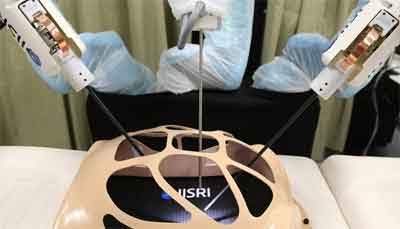- Home
- Editorial
- News
- Practice Guidelines
- Anesthesiology Guidelines
- Cancer Guidelines
- Cardiac Sciences Guidelines
- Critical Care Guidelines
- Dentistry Guidelines
- Dermatology Guidelines
- Diabetes and Endo Guidelines
- Diagnostics Guidelines
- ENT Guidelines
- Featured Practice Guidelines
- Gastroenterology Guidelines
- Geriatrics Guidelines
- Medicine Guidelines
- Nephrology Guidelines
- Neurosciences Guidelines
- Obs and Gynae Guidelines
- Ophthalmology Guidelines
- Orthopaedics Guidelines
- Paediatrics Guidelines
- Psychiatry Guidelines
- Pulmonology Guidelines
- Radiology Guidelines
- Surgery Guidelines
- Urology Guidelines
HeroSurg - Worlds first robotic surgeon with a sense of touch developed

Melbourne : Researchers, including one of Indian-origin, claim to have developed the world's first robotic surgical system that can give surgeons the sense of touch while they conduct keyhole surgery using a computer.
The HeroSurg robot is a major breakthrough to current technology, which now limits robotic surgery to the sense of sight, and means laparoscopic or keyhole/micro surgery will be safer and more accurate than ever before by reducing trauma and lowering risk of blood loss and infection.
HeroSurg was developed by engineers from Deakin University in Australia and Harvard University in the US, along with Suren Krishnan from the Royal Adelaide Hospital and an Honorary Professor at Institute for Intelligent Systems Research and Innovation (IISRI).
Krishnan said Hero Surg's addition of the sense of touch, provided through technology known as haptic feedback, would lead to better patient outcomes."The major drawback of the current system is the lack of tactile feedback," Krishnan said.
"Tactile feedback allows a surgeon to differentiate between tissues and to 'feel' delicate tissues weakened by infection or inflammation and dissect them more carefully. Tactile feedback will allow us to use finer and more delicate sutures in microsurgery," he said.
Krishnan said the haptics technology would also improve the ability to distinguish between tissues involved with cancer from normal tissue.
The project's lead researcher Mohsen Moradi Dalvand, a visiting scholar at Harvard, said the haptic feedback improved safety and allowed specific manoeuvres and diagnoses to be performed with greater confidence.
"HeroSurg's unique features which allow it to overcome many of the limitations of existing robotic laparoscopic systems, include collision avoidance capability, modularity and automatic patient/bed adjustment," Dalvand said.
"The automatic collision avoidance enables surgeons to operate with peace of mind and confidence that there will be no collision with instruments, the robot's arms, or the laparoscope with the patient," he said. Other unique HeroSurg features include high-resolution 3D images, an increased range of motion for the surgeon, and a more ergonomic workstation console.
"HeroSurg will assist surgeons to perform demanding surgical procedures with comfort, accuracy and safety by providing real-time collision avoidance for medical instruments, and stereo-endoscopic vision," Dalvand said.
He added that the extra real-time 3D virtual Hero Surg would help the surgeon identify the position relationship of the instruments and laparoscope. IISRI Director Professor Saeid Nahavandi said HeroSurg could be used remotely, with the surgeon potentially thousands of kilometres away from the actual theatre.

Disclaimer: This site is primarily intended for healthcare professionals. Any content/information on this website does not replace the advice of medical and/or health professionals and should not be construed as medical/diagnostic advice/endorsement or prescription. Use of this site is subject to our terms of use, privacy policy, advertisement policy. © 2020 Minerva Medical Treatment Pvt Ltd